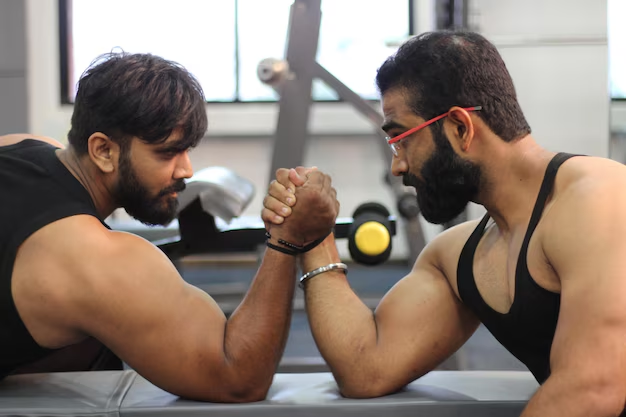
Working Out
The concept of working out with two partners has gained momentum, and Romina Boudoir stands out in this space. This approach offers a dynamic, challenging, and engaging way to reach fitness goals. With a focus on teamwork and energy, exercising alongside two others pushes boundaries, increases motivation, and creates a supportive environment. Whether aiming for strength, endurance, or just wanting to try something new, this style brings a refreshing twist to traditional workouts. Discover how Romina Boudoir’s unique approach can transform your fitness journey with the guidance and camaraderie of two dedicated partners.
The Unique Role of Romina Boudoir in Fitness
Romina Boudoir brings a fresh perspective to fitness, blending physical training with a sense of camaraderie and empowerment. Unlike conventional gyms, this approach embraces a more holistic view of exercising, focusing not only on the physical gains but also on mental and social aspects. The atmosphere is welcoming, encouraging participants to connect, share experiences, and push their limits together.
The setting in Romina Boudoir is designed to create an engaging environment where everyone feels motivated. There’s a sense of belonging that makes people feel comfortable, whether they’re experienced or just starting. This inclusive culture fosters genuine connections, making it easier to stay committed to the fitness journey.
In addition, Romina Boudoir’s emphasis on group workouts, specifically with two partners, offers an interesting dynamic. This structure promotes mutual support, allowing everyone to share tips, motivate one another, and celebrate progress as a team. This shared experience helps participants develop stronger bonds, making each session more enjoyable and encouraging long-term dedication.

By focusing on not just the physical training but also on building a positive mindset and supportive community, Romina Boudoir stands out as a unique fitness space that goes beyond the ordinary gym experience. It creates a space where fitness meets fun, challenge meets camaraderie, and individual goals are achieved through collective effort.
Benefits of Working Out with Two Guys
Choosing to work out with two partners offers a dynamic and multifaceted experience, different from solo or traditional pair exercises. The blend of energy, support, and motivation creates an environment that pushes individuals to reach their full potential. Here’s how this approach stands out in physical, mental, and social aspects:
3.1 Physical Benefits
Working out with two partners amplifies the intensity and effectiveness of training sessions. The added energy and encouragement help push through tougher routines, resulting in better physical outcomes. Here’s how it makes a difference:
- Enhanced Strength and Endurance: Having two partners means there’s constant encouragement to push beyond regular limits. It’s easier to tackle challenging exercises when others are there to provide support and motivation.
- Variety in Workouts: Exercising with multiple partners introduces a broader range of exercises. Each person can bring in different techniques or routines, which prevents workouts from becoming repetitive. This variation leads to a more comprehensive development of muscles and overall fitness.
- Better Technique and Form: Two partners can offer immediate feedback on form and technique, reducing the risk of injuries. They can spot mistakes and help correct them, ensuring that each exercise is performed effectively.
3.2 Mental Benefits
The mental advantages of working out with two partners are just as impactful as the physical ones. The experience offers a more enjoyable and engaging way to exercise, which positively affects overall mental health.
- Increased Motivation: It’s easy to skip a workout when training alone, but having two partners makes it harder to miss a session. Their presence keeps everyone accountable and motivated, making it easier to stay consistent.
- Reduced Stress and Anxiety: The social interaction and shared effort during group workouts create a sense of belonging and support, helping to alleviate stress. Knowing that others are working toward similar goals creates a more relaxed and enjoyable atmosphere.
- Boost in Confidence: Overcoming challenges with two supportive partners builds self-confidence. Celebrating achievements together, no matter how small, reinforces a positive mindset and the belief in one’s capabilities.
3.3 Social Benefits
The social aspect of working out with two partners can be one of the most rewarding elements. It transforms a regular fitness routine into an experience that fosters friendships and strengthens connections.
- Stronger Bonds and Friendships: Sharing the journey of fitness brings people closer together. The effort, struggles, and triumphs create a bond that often extends beyond the workout sessions. These friendships can become a powerful motivator, keeping everyone engaged and committed.
- Teamwork and Collaboration: Group workouts teach the value of working together toward common goals. Supporting each other, celebrating successes, and overcoming challenges as a team build a sense of unity.
- Increased Enjoyment: Exercising with two partners adds an element of fun to the routine. The shared laughter, encouragement, and competitive spirit make the experience more enjoyable, making it feel less like a chore and more like a social activity.
The combined physical, mental, and social benefits make working out with two partners a truly rewarding experience. It’s an approach that not only enhances fitness but also builds a supportive and motivating community, making the journey more enjoyable and effective.
Creating a Safe and Inclusive Workout Environment
A safe and inclusive workout environment is key to achieving the best results when training with two partners. This approach not only enhances physical performance but also ensures everyone feels respected, supported, and motivated. Here’s how to cultivate such an environment:
4.1 The Importance of Consent
Consent is the foundation of a respectful and comfortable workout space. It involves clear communication and mutual understanding of boundaries during each session.
- Clear Communication: Before starting any routine, discuss each person’s comfort levels with exercises, intensity, and physical contact. Establishing this early creates a sense of trust and understanding.
- Checking In Regularly: Throughout the session, check in with each other to make sure everyone feels comfortable. This practice helps prevent misunderstandings and fosters a more positive experience.
- Respecting Personal Space: Not every participant may be comfortable with physical assistance. Always ask before offering a helping hand or making any adjustments, and respect their response.
4.2 Addressing Potential Concerns
Creating a safe environment also means being aware of and addressing any potential issues that may arise. Addressing concerns openly ensures everyone feels valued and understood.
- Open Discussions about Comfort Levels: Encourage honest conversations about what exercises or movements feel challenging or uncomfortable. This helps prevent injuries and builds a more inclusive experience.
- Managing Different Fitness Levels: Partners may have varying fitness abilities, so it’s important to adjust exercises to accommodate everyone. Offering alternatives or modified versions of routines ensures that all participants can fully engage.
- Handling Misunderstandings: If conflicts or misunderstandings occur, address them calmly and openly. A willingness to listen and adapt promotes a more supportive environment.
4.3 Creating a Positive Atmosphere
A positive atmosphere is key to maintaining motivation and enjoyment during group workouts. This includes celebrating successes, offering encouragement, and maintaining a spirit of teamwork.
- Encouragement and Support: Regularly cheer on your partners and acknowledge their progress. Positive reinforcement can boost confidence and motivate everyone to push harder.
- Sharing the Leadership Role: Allow each partner to take turns leading the session or introducing new exercises. This creates a sense of equality and encourages everyone to contribute.
- Maintaining a Fun and Engaging Attitude: Incorporate fun elements into the workout, such as challenges or partner games. A lighthearted approach makes the experience enjoyable and keeps motivation high.
By focusing on consent, addressing concerns, and fostering a positive atmosphere, the group can create a workout environment that feels safe, inclusive, and rewarding for everyone involved. This approach not only helps achieve fitness goals but also strengthens the bond between partners, making each session an enjoyable experience.
Tips for Working Out with Two Partners Effectively
Training with two partners can be highly rewarding, but it requires a thoughtful approach to make the most of the experience. By focusing on communication, setting goals, and maintaining proper technique, the group can enjoy a productive and enjoyable workout session. Here’s a guide to making the most out of this dynamic:

5.1 Setting Clear Goals
Having clear goals helps maintain focus and ensures that all partners are working toward a shared purpose.
- Discuss Individual Objectives: Each person might have different fitness goals, such as building strength, improving endurance, or increasing flexibility. Take time to share these objectives and find common ground.
- Create Shared Milestones: Establish milestones that the group can work toward together, such as completing a certain number of reps or mastering a challenging exercise. This shared vision fosters teamwork and makes progress more enjoyable.
- Regularly Reassess Goals: As the group progresses, revisit goals and adjust them based on improvements and changing preferences. This helps maintain motivation and keeps the sessions aligned with everyone’s evolving fitness journey.
5.2 Finding the Right Workout Routine
The effectiveness of trio workouts often depends on finding routines that suit all participants. The right exercises should be engaging, challenging, and adaptable to different fitness levels.
- Balance Strength, Cardio, and Flexibility: Incorporate a mix of exercises that cover strength training, cardiovascular activities, and flexibility routines. This balanced approach caters to a variety of fitness needs and keeps the sessions dynamic.
- Rotate Exercises Regularly: To prevent monotony and keep everyone engaged, rotate through different routines. Allow each partner to introduce new exercises or variations, which adds variety and keeps the workout sessions interesting.
- Adapt to Individual Abilities: Not everyone will be at the same fitness level, so choose exercises that can be modified. This ensures that each person can participate fully and work at their own pace while still contributing to the group’s success.
5.3 Proper Technique and Form
Maintaining proper form is essential for preventing injuries and maximizing the effectiveness of each exercise. When working out with partners, this aspect becomes even more important.
- Monitor Each Other’s Form: Encourage each partner to provide feedback on technique. Constructive suggestions help maintain correct posture and prevent bad habits from developing.
- Use Partner-Assisted Techniques: Incorporate exercises that allow partners to assist each other, such as spotting during weightlifting or providing resistance during stretches. This not only improves form but also strengthens trust and cooperation.
- Take Time to Warm Up and Cool Down: Start each session with a warm-up to prepare the body and finish with a cool-down to aid recovery. This routine reduces the risk of injury and promotes better performance in each workout.
5.4 Nutrition and Hydration
Nutrition and hydration play a vital role in achieving fitness goals, especially when training with others. Proper fuel enhances performance and recovery.
- Stay Hydrated Together: Remind each other to drink water before, during, and after workouts. Hydration helps maintain energy levels and prevents fatigue, ensuring that everyone can perform at their best.
- Share Healthy Snacks or Meal Ideas: Consider exchanging nutritious recipes or snacks that support muscle recovery and energy replenishment. This not only boosts physical results but also adds a social element to the fitness journey.
- Understand Individual Dietary Needs: Recognize that each person might have different dietary preferences or requirements. Respecting these differences creates a more supportive environment and encourages healthy habits.
By incorporating these tips, working out with two partners becomes a more effective, enjoyable, and supportive experience. It’s about more than just physical gains; it’s an opportunity to grow together, learn from each other, and build a sense of camaraderie that makes every session both productive and rewarding.
Real-Life Experiences and Testimonials
Hearing about real-life experiences can offer valuable insights into the benefits and challenges of working out with two partners. These stories highlight how this approach goes beyond regular fitness routines, transforming both the physical and social aspects of training. Here’s a look at some common themes and takeaways from those who have embraced this journey.
6.1 Success Stories
Many individuals have experienced significant transformations, both in their fitness levels and personal lives, by working out with two partners.
- Improved Strength and Endurance: Several people have reported notable gains in strength and endurance, attributing this progress to the extra motivation provided by their partners. Pushing each other to complete an extra set or rep often leads to faster and more consistent improvements.
- Reaching Milestones Faster: Having two partners adds an element of accountability, making it easier to stay on track with goals. Many have mentioned how this support helped them reach personal milestones, such as lifting heavier weights, running longer distances, or mastering advanced techniques.
- Building Confidence: The shared experience of tackling challenges and celebrating achievements has helped participants feel more confident in their abilities. This boost in self-esteem often extends to other areas of life, demonstrating the broader impact of this workout style.
6.2 Overcoming Challenges and Adaptations
While the journey is often rewarding, it’s not without its obstacles. Here’s how some have navigated common challenges:
- Managing Different Fitness Levels: One of the most frequent challenges is finding a balance between varying fitness abilities. Successful groups often emphasize open communication, allowing each person to adjust exercises to their level without feeling left out. This flexibility creates an environment where everyone can progress at their own pace.
- Maintaining Consistency: Scheduling can be a hurdle when coordinating with two others. Many groups have found that setting a fixed routine or meeting on the same days each week helps maintain consistency. This approach reduces the chances of missed sessions and keeps everyone committed.
- Dealing with Injuries and Setbacks: Injuries can be discouraging, but having two partners means there’s always support to help adapt the workout routine. Some participants have shared how their partners adjusted exercises or provided motivation during recovery, making it easier to stay engaged despite setbacks.
6.3 Building Strong Friendships and Connections
A unique aspect of working out with two partners is the opportunity to build deep and lasting connections.
- Mutual Support and Encouragement: Many people have found that the support offered by their partners goes beyond the workout itself. Encouraging each other through tough moments creates a bond that often extends into other areas of life, such as personal challenges or career goals.
- Creating a Sense of Belonging: The shared journey fosters a sense of belonging and community, which is often hard to find in other fitness settings. Participants have described feeling like they are part of a team, which makes the process of working out far more enjoyable.
- Celebrating Success Together: Reaching a goal feels more rewarding when shared with others who understand the effort involved. Whether it’s achieving a personal record or mastering a challenging routine, having partners to celebrate with enhances the experience and creates lasting memories.
These real-life experiences and testimonials highlight the profound impact that working out with two partners can have. The combination of physical achievements, personal growth, and the development of strong friendships makes this approach to fitness more than just a routine; it becomes a journey filled with shared triumphs, learning moments, and lasting connections.
How to Get Started at Romina Boudoir
Beginning a fitness journey at Romina Boudoir with two partners can be an exciting and rewarding experience. Whether you’re new to this style or looking to enhance your current routine, taking the right steps will help set the stage for success. Here’s how to start effectively and make the most of your time.Beginning a fitness journey at Romina Boudoir with two partners can be an exciting and rewarding experience.

7.1 Finding the Right Workout Partners
The first step is selecting partners who share similar goals, commitment levels, and attitudes toward fitness.
- Shared Fitness Goals: It’s helpful to choose partners who have aligned objectives, whether it’s building strength, improving endurance, or enhancing flexibility. This alignment makes it easier to plan routines and stay motivated.
- Complementary Skills and Strengths: Having partners with different skills or strengths can add variety to your workouts. For example, one person might excel in cardio, while another is skilled in strength training. This diversity brings balance to each session.
- Consistency and Commitment: Consistency is key in any fitness journey, so it’s important to find partners who can commit to regular sessions. Look for individuals who are reliable and willing to support each other’s progress.
7.2 Establishing Goals and Routines for Long-Term Success
Once you have your partners, it’s time to set clear goals and create a routine that everyone can follow.
- Start with a Planning Session: Take time to discuss what each person wants to achieve and how you can work together. This planning session helps establish a shared vision and sets the foundation for an effective workout routine.
- Create a Balanced Workout Schedule: Mix strength, cardio, and flexibility exercises to keep the sessions engaging. Plan a weekly schedule that accommodates everyone’s availability, ensuring there’s a good balance of rest and activity.
- Track Progress Regularly: Use a shared fitness journal or app to track individual and group progress. Recording achievements helps maintain motivation and allows you to adjust the routine as needed.
7.3 Tips for First-Timers
For those who are trying this workout style for the first time, there are a few strategies that can help make the experience enjoyable and effective.
- Start Slow and Build Gradually: It’s tempting to jump into intense workouts, but beginning with moderate exercises helps prevent injuries and builds a solid foundation. As you become more comfortable, increase the intensity and complexity of the routines.
- Focus on Communication: Regularly check in with your partners about how the workouts feel and if any adjustments are needed. Open communication prevents misunderstandings and helps everyone feel comfortable and included.
- Celebrate Small Wins: Recognize and celebrate even the smallest achievements. Whether it’s completing an extra rep or mastering a new exercise, acknowledging progress keeps motivation high and strengthens the bond between partners.
By following these steps, getting started at Romina Boudoir becomes a smoother and more enjoyable experience. It’s about building a supportive environment where everyone can pursue their fitness goals together, creating a journey that’s as fulfilling as it is effective.
Conclusion
The journey of working out with two partners at Romina Boudoir presents a unique blend of physical, mental, and social benefits. Through shared goals, effective communication, and a supportive environment, participants can achieve impressive fitness results while forging strong friendships. This collaborative approach not only enhances motivation but also fosters a sense of community that enriches the overall experience. As individuals support one another in overcoming challenges and celebrating successes, the workout becomes more than just an exercise routine; it transforms into a rewarding adventure that promotes personal growth and lasting connections. Embracing this opportunity can lead to a fulfilling fitness journey that inspires all involved to reach their fullest potential.





